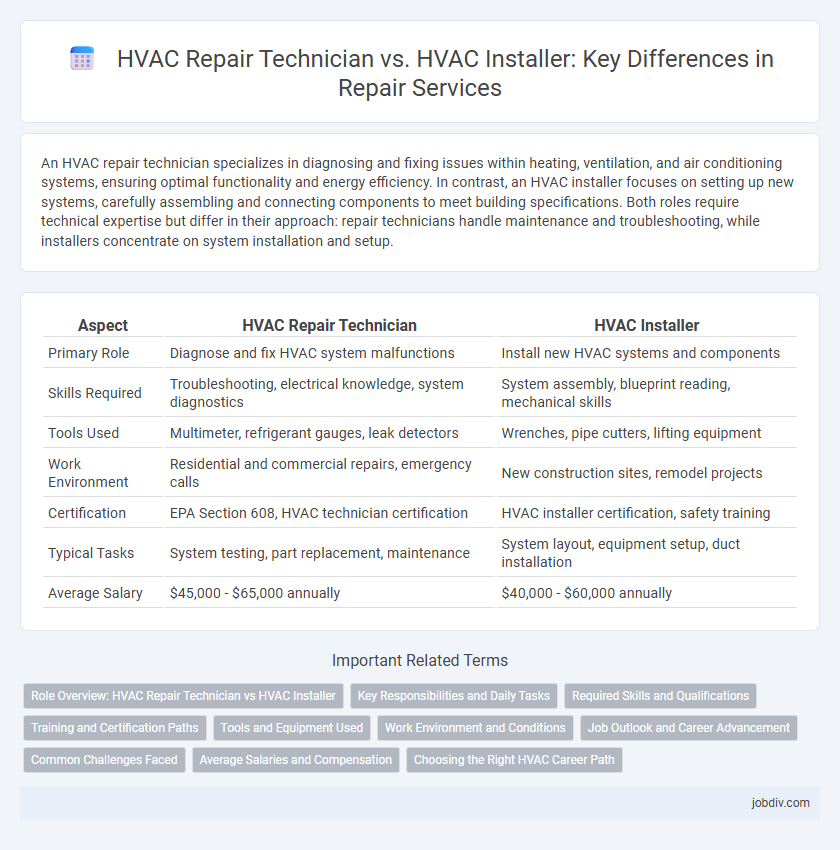An HVAC repair technician specializes in diagnosing and fixing issues within heating, ventilation, and air conditioning systems, ensuring optimal functionality and energy efficiency. In contrast, an HVAC installer focuses on setting up new systems, carefully assembling and connecting components to meet building specifications. Both roles require technical expertise but differ in their approach: repair technicians handle maintenance and troubleshooting, while installers concentrate on system installation and setup.
Table of Comparison
| Aspect | HVAC Repair Technician | HVAC Installer |
|---|---|---|
| Primary Role | Diagnose and fix HVAC system malfunctions | Install new HVAC systems and components |
| Skills Required | Troubleshooting, electrical knowledge, system diagnostics | System assembly, blueprint reading, mechanical skills |
| Tools Used | Multimeter, refrigerant gauges, leak detectors | Wrenches, pipe cutters, lifting equipment |
| Work Environment | Residential and commercial repairs, emergency calls | New construction sites, remodel projects |
| Certification | EPA Section 608, HVAC technician certification | HVAC installer certification, safety training |
| Typical Tasks | System testing, part replacement, maintenance | System layout, equipment setup, duct installation |
| Average Salary | $45,000 - $65,000 annually | $40,000 - $60,000 annually |
Role Overview: HVAC Repair Technician vs HVAC Installer
HVAC repair technicians specialize in diagnosing and fixing malfunctions in heating, ventilation, and air conditioning systems, ensuring optimal performance and energy efficiency. HVAC installers focus on setting up, configuring, and commissioning new HVAC units, adhering to building codes and manufacturer specifications. Both roles require technical expertise but differ in their primary responsibilities: troubleshooting and maintenance versus installation and setup.
Key Responsibilities and Daily Tasks
HVAC repair technicians specialize in diagnosing, troubleshooting, and fixing heating, ventilation, and air conditioning systems to ensure optimal performance and safety. Their daily tasks include inspecting HVAC units, replacing faulty components, and conducting routine maintenance to prevent system failures. In contrast, HVAC installers focus on assembling, installing, and testing new HVAC systems according to manufacturer specifications and building codes.
Required Skills and Qualifications
HVAC repair technicians require strong diagnostic skills, proficiency in troubleshooting heating, ventilation, and air conditioning systems, and certifications such as EPA 608 for handling refrigerants. HVAC installers must have expertise in system layout, equipment installation, and adherence to local building codes, often backed by formal training or apprenticeship programs. Both roles demand knowledge of electrical systems, mechanical aptitude, and safety protocols, though repair technicians focus more on problem-solving existing systems, whereas installers specialize in accurate system setup.
Training and Certification Paths
HVAC repair technicians typically complete specialized training programs focused on diagnosing and fixing heating, ventilation, and air conditioning systems, often obtaining certifications such as EPA 608 and NATE to validate their repair expertise. In contrast, HVAC installers emphasize training in system design, installation procedures, and load calculations, with certifications like HVAC Excellence or ACCA to demonstrate proficiency in proper unit installation and compliance with industry standards. Both career paths require a combination of classroom instruction, hands-on apprenticeships, and ongoing education to keep up with evolving technologies and regulations.
Tools and Equipment Used
HVAC repair technicians primarily use diagnostic tools such as multimeters, refrigerant gauges, and leak detectors to identify and fix system issues, ensuring optimal performance and safety. HVAC installers rely on equipment like pipe cutters, tubing benders, and welding tools to set up new heating, ventilation, and air conditioning systems accurately. Both roles require specialized hand tools, but repair technicians focus more on testing and troubleshooting devices, while installers emphasize assembly and installation precision.
Work Environment and Conditions
HVAC repair technicians typically work in varied environments that include residential, commercial, and industrial settings, often dealing with urgent breakdowns and requiring troubleshooting skills under time constraints. HVAC installers primarily perform installation tasks at new construction sites or during major renovations, working outdoors or in partially finished buildings, often in physically demanding conditions. Both roles require handling heavy equipment and exposure to temperature extremes, but repair technicians face more unpredictability and immediate customer service challenges.
Job Outlook and Career Advancement
HVAC repair technicians have a positive job outlook due to ongoing maintenance demands and system upgrades, leading to steady employment opportunities. HVAC installers benefit from growing construction and renovation projects, with career advancement often involving supervisory or specialized installation roles. Both careers show promising growth, but technicians may find more diverse paths in troubleshooting and system optimization.
Common Challenges Faced
HVAC repair technicians frequently encounter diagnostic difficulties such as pinpointing malfunctioning components within complex systems, while HVAC installers face challenges related to ensuring proper system integration and compliance with building codes. Both roles require extensive knowledge of electrical wiring, refrigerant handling, and safety protocols, with repair technicians often addressing unexpected system breakdowns and installers managing precise equipment alignment. Time management and staying updated with evolving HVAC technologies remain critical challenges for professionals in both fields.
Average Salaries and Compensation
HVAC repair technicians earn an average salary ranging from $40,000 to $60,000 annually, with compensation varying based on experience and location. HVAC installers typically receive slightly lower average salaries, around $35,000 to $55,000, though installers may benefit from different performance-based bonuses and commissions. Both roles offer opportunities for overtime pay and certifications that can significantly enhance earnings.
Choosing the Right HVAC Career Path
Choosing the right HVAC career path depends on whether you prefer problem-solving and maintenance or system installation and setup. HVAC repair technicians specialize in diagnosing, fixing, and maintaining heating, ventilation, and air conditioning systems, requiring strong technical skills and troubleshooting expertise. HVAC installers focus on assembling and installing new HVAC systems, emphasizing physical endurance and knowledge of building codes and safety standards.
HVAC Repair Technician vs HVAC Installer Infographic

 jobdiv.com
jobdiv.com